Business Research Proposal: Internal Auditors and Corporate Governance
VerifiedAdded on 2022/11/17
|17
|5924
|285
Report
AI Summary
This business research paper investigates the crucial role of internal auditors in corporate governance. The research delves into the responsibilities and contributions of internal auditors, highlighting their significance in ensuring financial reporting accuracy, monitoring risk management processes, and contributing to overall corporate governance. The study explores the evolution of internal audit processes, the impact of outsourcing versus insourcing, and the influence of organizational status on internal audit functions. The paper examines the importance of skilled internal auditors, their qualifications, and the necessary behavioral and cognitive skills. Furthermore, it analyzes internal audit activities, focusing on risk management and consulting services. The research proposes strategies for efficient engagement of internal auditors to enhance transparency within internal control systems and overall governance, providing valuable insights for business development.
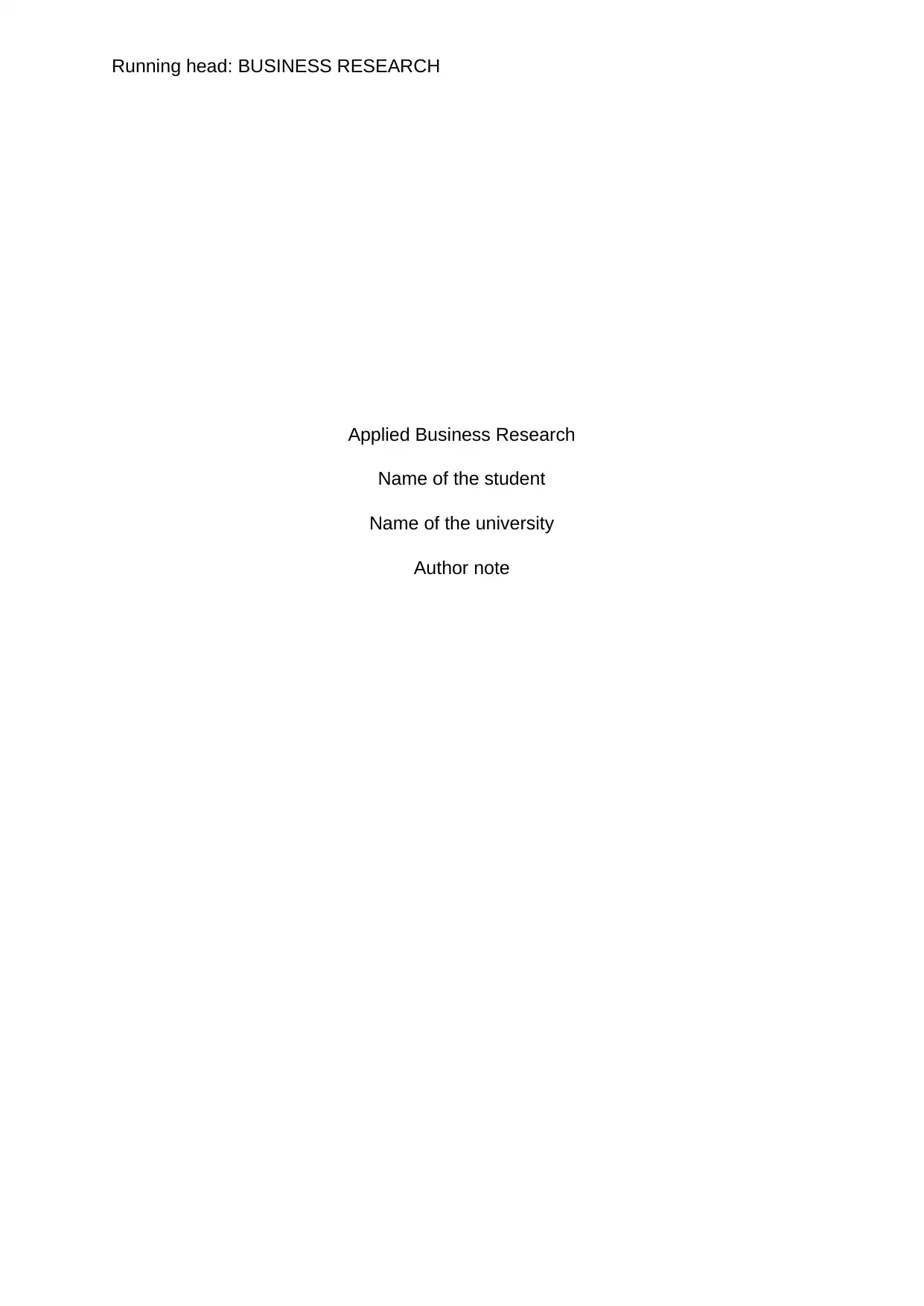
Running head: BUSINESS RESEARCH
Applied Business Research
Name of the student
Name of the university
Author note
Applied Business Research
Name of the student
Name of the university
Author note
Paraphrase This Document
Need a fresh take? Get an instant paraphrase of this document with our AI Paraphraser
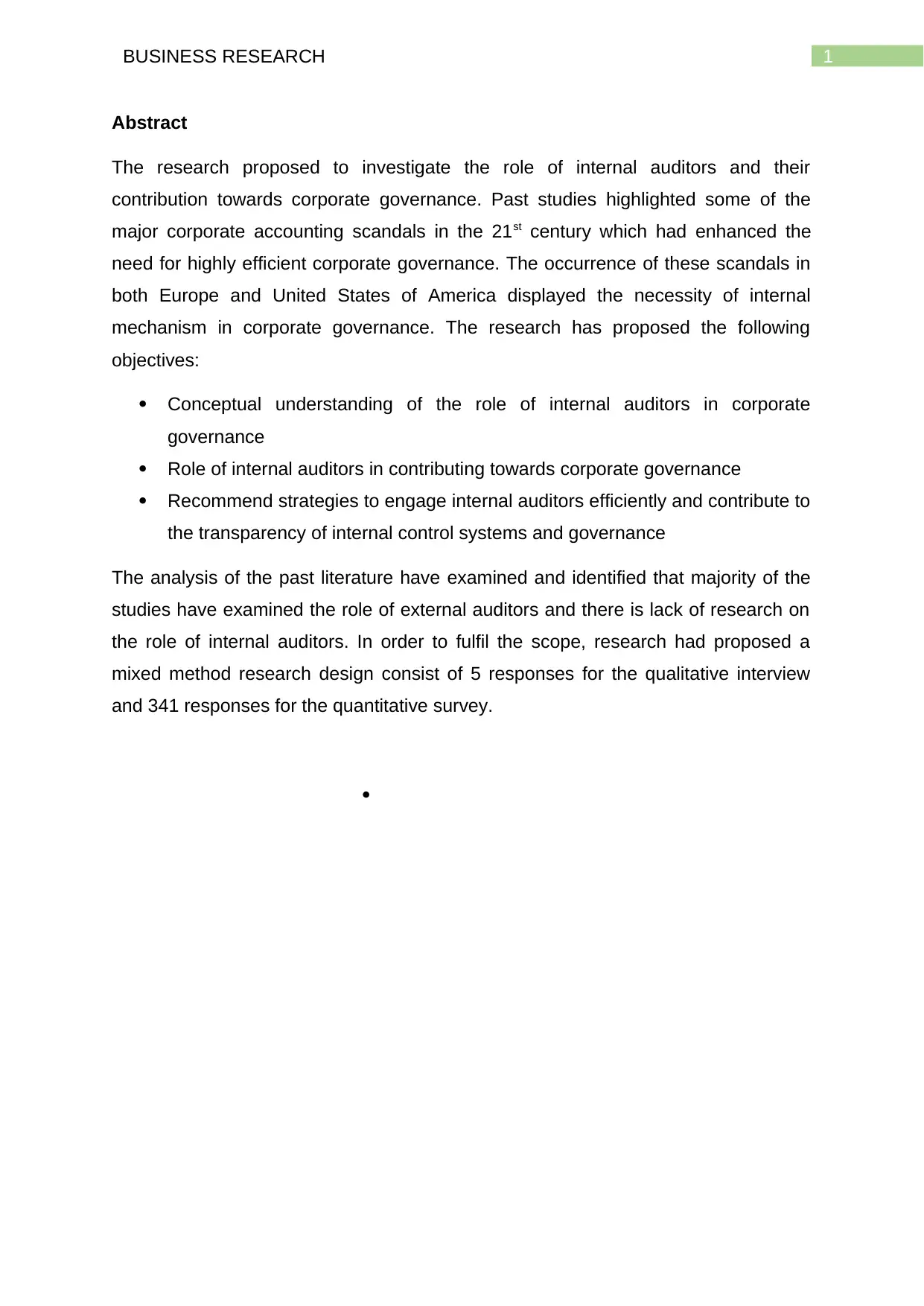
1BUSINESS RESEARCH
Abstract
The research proposed to investigate the role of internal auditors and their
contribution towards corporate governance. Past studies highlighted some of the
major corporate accounting scandals in the 21st century which had enhanced the
need for highly efficient corporate governance. The occurrence of these scandals in
both Europe and United States of America displayed the necessity of internal
mechanism in corporate governance. The research has proposed the following
objectives:
Conceptual understanding of the role of internal auditors in corporate
governance
Role of internal auditors in contributing towards corporate governance
Recommend strategies to engage internal auditors efficiently and contribute to
the transparency of internal control systems and governance
The analysis of the past literature have examined and identified that majority of the
studies have examined the role of external auditors and there is lack of research on
the role of internal auditors. In order to fulfil the scope, research had proposed a
mixed method research design consist of 5 responses for the qualitative interview
and 341 responses for the quantitative survey.
Abstract
The research proposed to investigate the role of internal auditors and their
contribution towards corporate governance. Past studies highlighted some of the
major corporate accounting scandals in the 21st century which had enhanced the
need for highly efficient corporate governance. The occurrence of these scandals in
both Europe and United States of America displayed the necessity of internal
mechanism in corporate governance. The research has proposed the following
objectives:
Conceptual understanding of the role of internal auditors in corporate
governance
Role of internal auditors in contributing towards corporate governance
Recommend strategies to engage internal auditors efficiently and contribute to
the transparency of internal control systems and governance
The analysis of the past literature have examined and identified that majority of the
studies have examined the role of external auditors and there is lack of research on
the role of internal auditors. In order to fulfil the scope, research had proposed a
mixed method research design consist of 5 responses for the qualitative interview
and 341 responses for the quantitative survey.
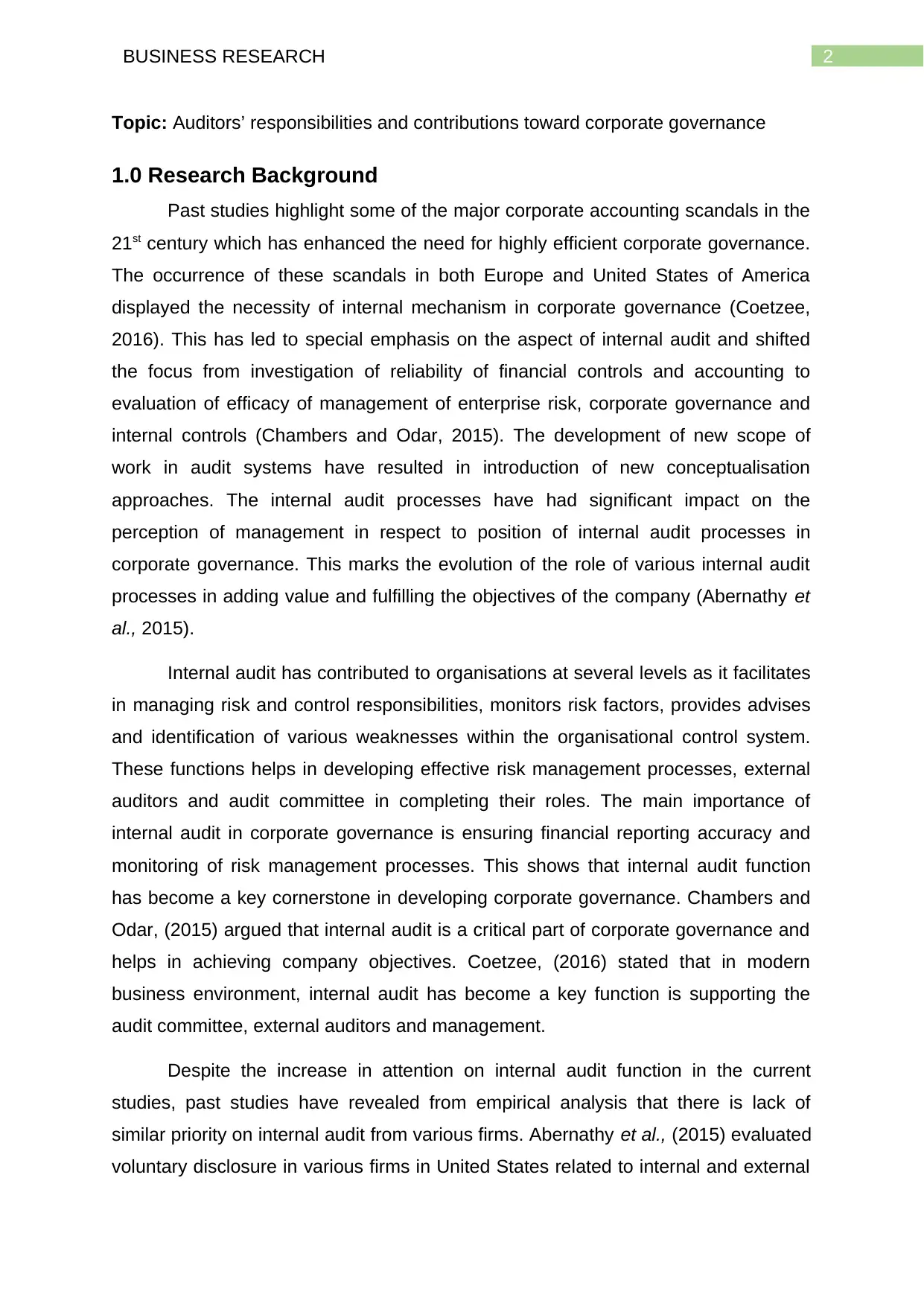
2BUSINESS RESEARCH
Topic: Auditors’ responsibilities and contributions toward corporate governance
1.0 Research Background
Past studies highlight some of the major corporate accounting scandals in the
21st century which has enhanced the need for highly efficient corporate governance.
The occurrence of these scandals in both Europe and United States of America
displayed the necessity of internal mechanism in corporate governance (Coetzee,
2016). This has led to special emphasis on the aspect of internal audit and shifted
the focus from investigation of reliability of financial controls and accounting to
evaluation of efficacy of management of enterprise risk, corporate governance and
internal controls (Chambers and Odar, 2015). The development of new scope of
work in audit systems have resulted in introduction of new conceptualisation
approaches. The internal audit processes have had significant impact on the
perception of management in respect to position of internal audit processes in
corporate governance. This marks the evolution of the role of various internal audit
processes in adding value and fulfilling the objectives of the company (Abernathy et
al., 2015).
Internal audit has contributed to organisations at several levels as it facilitates
in managing risk and control responsibilities, monitors risk factors, provides advises
and identification of various weaknesses within the organisational control system.
These functions helps in developing effective risk management processes, external
auditors and audit committee in completing their roles. The main importance of
internal audit in corporate governance is ensuring financial reporting accuracy and
monitoring of risk management processes. This shows that internal audit function
has become a key cornerstone in developing corporate governance. Chambers and
Odar, (2015) argued that internal audit is a critical part of corporate governance and
helps in achieving company objectives. Coetzee, (2016) stated that in modern
business environment, internal audit has become a key function is supporting the
audit committee, external auditors and management.
Despite the increase in attention on internal audit function in the current
studies, past studies have revealed from empirical analysis that there is lack of
similar priority on internal audit from various firms. Abernathy et al., (2015) evaluated
voluntary disclosure in various firms in United States related to internal and external
Topic: Auditors’ responsibilities and contributions toward corporate governance
1.0 Research Background
Past studies highlight some of the major corporate accounting scandals in the
21st century which has enhanced the need for highly efficient corporate governance.
The occurrence of these scandals in both Europe and United States of America
displayed the necessity of internal mechanism in corporate governance (Coetzee,
2016). This has led to special emphasis on the aspect of internal audit and shifted
the focus from investigation of reliability of financial controls and accounting to
evaluation of efficacy of management of enterprise risk, corporate governance and
internal controls (Chambers and Odar, 2015). The development of new scope of
work in audit systems have resulted in introduction of new conceptualisation
approaches. The internal audit processes have had significant impact on the
perception of management in respect to position of internal audit processes in
corporate governance. This marks the evolution of the role of various internal audit
processes in adding value and fulfilling the objectives of the company (Abernathy et
al., 2015).
Internal audit has contributed to organisations at several levels as it facilitates
in managing risk and control responsibilities, monitors risk factors, provides advises
and identification of various weaknesses within the organisational control system.
These functions helps in developing effective risk management processes, external
auditors and audit committee in completing their roles. The main importance of
internal audit in corporate governance is ensuring financial reporting accuracy and
monitoring of risk management processes. This shows that internal audit function
has become a key cornerstone in developing corporate governance. Chambers and
Odar, (2015) argued that internal audit is a critical part of corporate governance and
helps in achieving company objectives. Coetzee, (2016) stated that in modern
business environment, internal audit has become a key function is supporting the
audit committee, external auditors and management.
Despite the increase in attention on internal audit function in the current
studies, past studies have revealed from empirical analysis that there is lack of
similar priority on internal audit from various firms. Abernathy et al., (2015) evaluated
voluntary disclosure in various firms in United States related to internal and external
⊘ This is a preview!⊘
Do you want full access?
Subscribe today to unlock all pages.

Trusted by 1+ million students worldwide
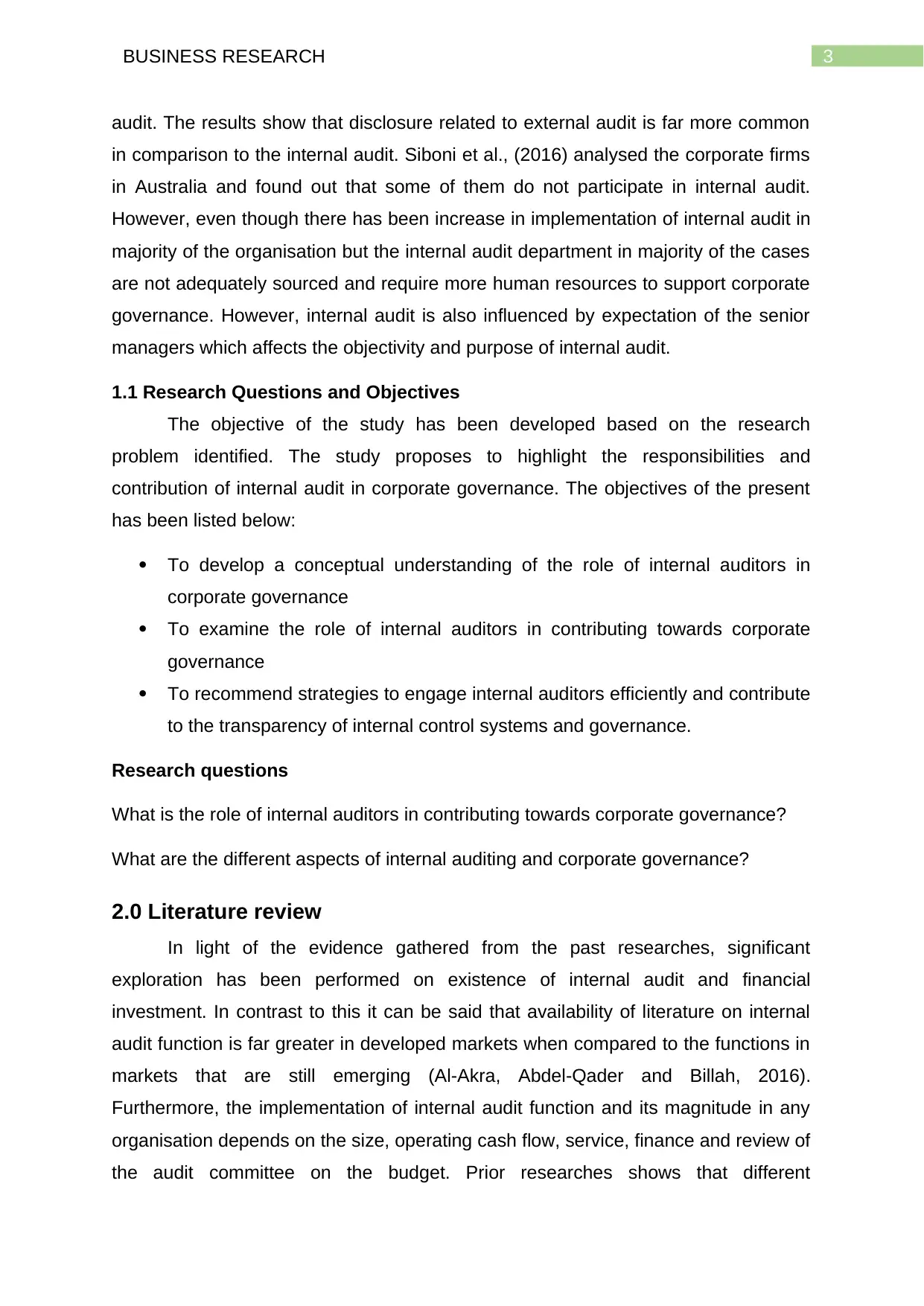
3BUSINESS RESEARCH
audit. The results show that disclosure related to external audit is far more common
in comparison to the internal audit. Siboni et al., (2016) analysed the corporate firms
in Australia and found out that some of them do not participate in internal audit.
However, even though there has been increase in implementation of internal audit in
majority of the organisation but the internal audit department in majority of the cases
are not adequately sourced and require more human resources to support corporate
governance. However, internal audit is also influenced by expectation of the senior
managers which affects the objectivity and purpose of internal audit.
1.1 Research Questions and Objectives
The objective of the study has been developed based on the research
problem identified. The study proposes to highlight the responsibilities and
contribution of internal audit in corporate governance. The objectives of the present
has been listed below:
To develop a conceptual understanding of the role of internal auditors in
corporate governance
To examine the role of internal auditors in contributing towards corporate
governance
To recommend strategies to engage internal auditors efficiently and contribute
to the transparency of internal control systems and governance.
Research questions
What is the role of internal auditors in contributing towards corporate governance?
What are the different aspects of internal auditing and corporate governance?
2.0 Literature review
In light of the evidence gathered from the past researches, significant
exploration has been performed on existence of internal audit and financial
investment. In contrast to this it can be said that availability of literature on internal
audit function is far greater in developed markets when compared to the functions in
markets that are still emerging (Al-Akra, Abdel-Qader and Billah, 2016).
Furthermore, the implementation of internal audit function and its magnitude in any
organisation depends on the size, operating cash flow, service, finance and review of
the audit committee on the budget. Prior researches shows that different
audit. The results show that disclosure related to external audit is far more common
in comparison to the internal audit. Siboni et al., (2016) analysed the corporate firms
in Australia and found out that some of them do not participate in internal audit.
However, even though there has been increase in implementation of internal audit in
majority of the organisation but the internal audit department in majority of the cases
are not adequately sourced and require more human resources to support corporate
governance. However, internal audit is also influenced by expectation of the senior
managers which affects the objectivity and purpose of internal audit.
1.1 Research Questions and Objectives
The objective of the study has been developed based on the research
problem identified. The study proposes to highlight the responsibilities and
contribution of internal audit in corporate governance. The objectives of the present
has been listed below:
To develop a conceptual understanding of the role of internal auditors in
corporate governance
To examine the role of internal auditors in contributing towards corporate
governance
To recommend strategies to engage internal auditors efficiently and contribute
to the transparency of internal control systems and governance.
Research questions
What is the role of internal auditors in contributing towards corporate governance?
What are the different aspects of internal auditing and corporate governance?
2.0 Literature review
In light of the evidence gathered from the past researches, significant
exploration has been performed on existence of internal audit and financial
investment. In contrast to this it can be said that availability of literature on internal
audit function is far greater in developed markets when compared to the functions in
markets that are still emerging (Al-Akra, Abdel-Qader and Billah, 2016).
Furthermore, the implementation of internal audit function and its magnitude in any
organisation depends on the size, operating cash flow, service, finance and review of
the audit committee on the budget. Prior researches shows that different
Paraphrase This Document
Need a fresh take? Get an instant paraphrase of this document with our AI Paraphraser
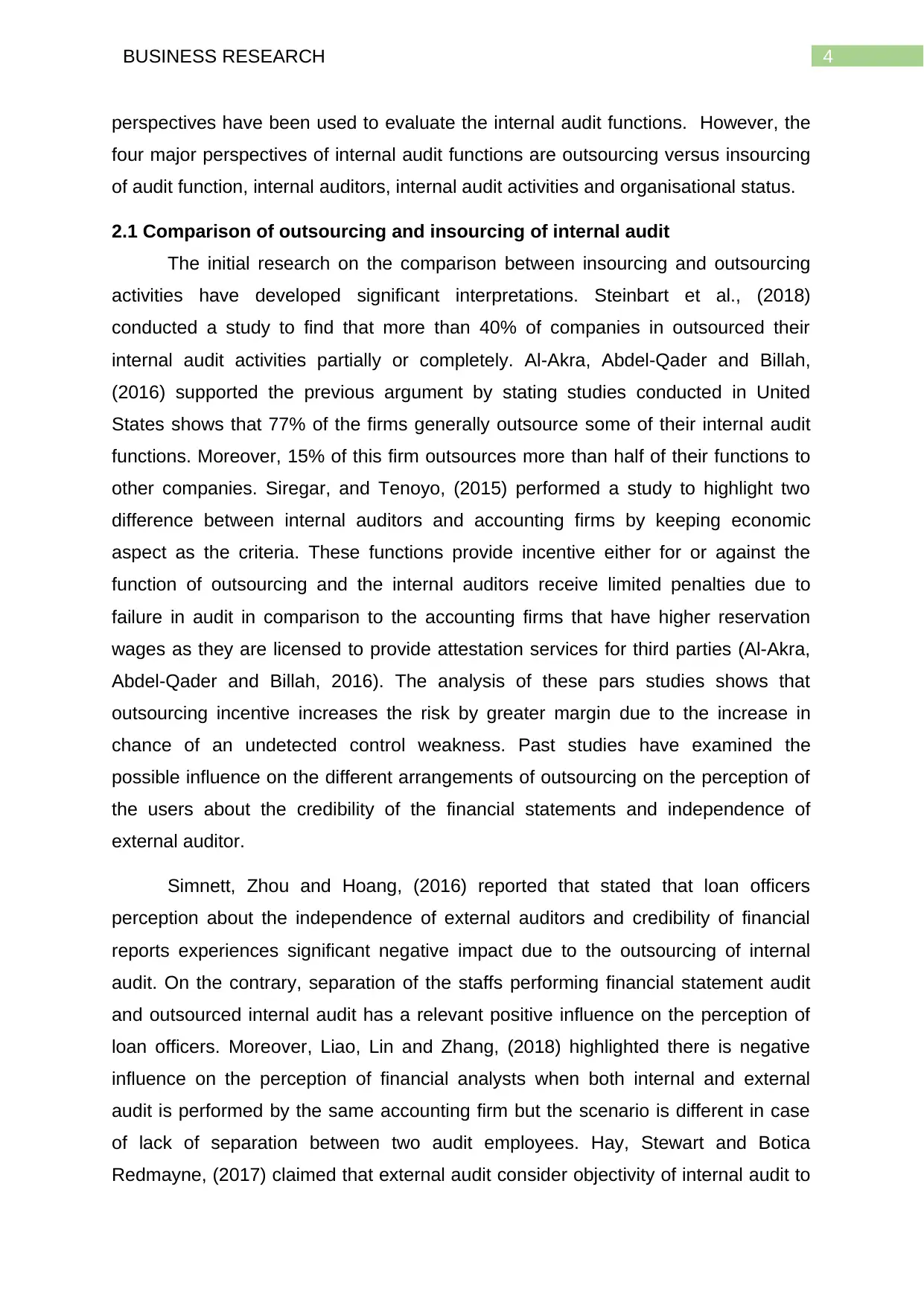
4BUSINESS RESEARCH
perspectives have been used to evaluate the internal audit functions. However, the
four major perspectives of internal audit functions are outsourcing versus insourcing
of audit function, internal auditors, internal audit activities and organisational status.
2.1 Comparison of outsourcing and insourcing of internal audit
The initial research on the comparison between insourcing and outsourcing
activities have developed significant interpretations. Steinbart et al., (2018)
conducted a study to find that more than 40% of companies in outsourced their
internal audit activities partially or completely. Al-Akra, Abdel-Qader and Billah,
(2016) supported the previous argument by stating studies conducted in United
States shows that 77% of the firms generally outsource some of their internal audit
functions. Moreover, 15% of this firm outsources more than half of their functions to
other companies. Siregar, and Tenoyo, (2015) performed a study to highlight two
difference between internal auditors and accounting firms by keeping economic
aspect as the criteria. These functions provide incentive either for or against the
function of outsourcing and the internal auditors receive limited penalties due to
failure in audit in comparison to the accounting firms that have higher reservation
wages as they are licensed to provide attestation services for third parties (Al-Akra,
Abdel-Qader and Billah, 2016). The analysis of these pars studies shows that
outsourcing incentive increases the risk by greater margin due to the increase in
chance of an undetected control weakness. Past studies have examined the
possible influence on the different arrangements of outsourcing on the perception of
the users about the credibility of the financial statements and independence of
external auditor.
Simnett, Zhou and Hoang, (2016) reported that stated that loan officers
perception about the independence of external auditors and credibility of financial
reports experiences significant negative impact due to the outsourcing of internal
audit. On the contrary, separation of the staffs performing financial statement audit
and outsourced internal audit has a relevant positive influence on the perception of
loan officers. Moreover, Liao, Lin and Zhang, (2018) highlighted there is negative
influence on the perception of financial analysts when both internal and external
audit is performed by the same accounting firm but the scenario is different in case
of lack of separation between two audit employees. Hay, Stewart and Botica
Redmayne, (2017) claimed that external audit consider objectivity of internal audit to
perspectives have been used to evaluate the internal audit functions. However, the
four major perspectives of internal audit functions are outsourcing versus insourcing
of audit function, internal auditors, internal audit activities and organisational status.
2.1 Comparison of outsourcing and insourcing of internal audit
The initial research on the comparison between insourcing and outsourcing
activities have developed significant interpretations. Steinbart et al., (2018)
conducted a study to find that more than 40% of companies in outsourced their
internal audit activities partially or completely. Al-Akra, Abdel-Qader and Billah,
(2016) supported the previous argument by stating studies conducted in United
States shows that 77% of the firms generally outsource some of their internal audit
functions. Moreover, 15% of this firm outsources more than half of their functions to
other companies. Siregar, and Tenoyo, (2015) performed a study to highlight two
difference between internal auditors and accounting firms by keeping economic
aspect as the criteria. These functions provide incentive either for or against the
function of outsourcing and the internal auditors receive limited penalties due to
failure in audit in comparison to the accounting firms that have higher reservation
wages as they are licensed to provide attestation services for third parties (Al-Akra,
Abdel-Qader and Billah, 2016). The analysis of these pars studies shows that
outsourcing incentive increases the risk by greater margin due to the increase in
chance of an undetected control weakness. Past studies have examined the
possible influence on the different arrangements of outsourcing on the perception of
the users about the credibility of the financial statements and independence of
external auditor.
Simnett, Zhou and Hoang, (2016) reported that stated that loan officers
perception about the independence of external auditors and credibility of financial
reports experiences significant negative impact due to the outsourcing of internal
audit. On the contrary, separation of the staffs performing financial statement audit
and outsourced internal audit has a relevant positive influence on the perception of
loan officers. Moreover, Liao, Lin and Zhang, (2018) highlighted there is negative
influence on the perception of financial analysts when both internal and external
audit is performed by the same accounting firm but the scenario is different in case
of lack of separation between two audit employees. Hay, Stewart and Botica
Redmayne, (2017) claimed that external audit consider objectivity of internal audit to
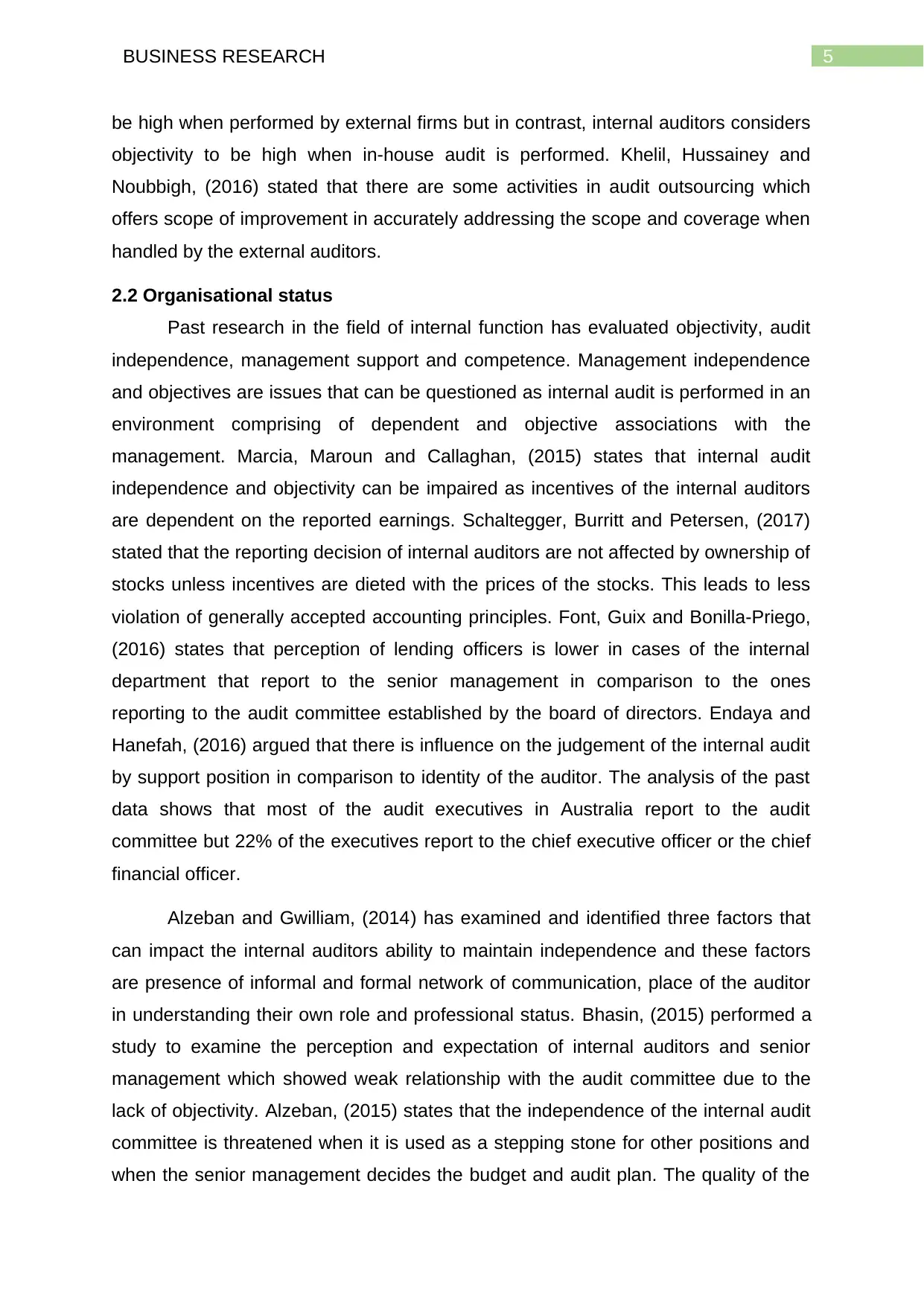
5BUSINESS RESEARCH
be high when performed by external firms but in contrast, internal auditors considers
objectivity to be high when in-house audit is performed. Khelil, Hussainey and
Noubbigh, (2016) stated that there are some activities in audit outsourcing which
offers scope of improvement in accurately addressing the scope and coverage when
handled by the external auditors.
2.2 Organisational status
Past research in the field of internal function has evaluated objectivity, audit
independence, management support and competence. Management independence
and objectives are issues that can be questioned as internal audit is performed in an
environment comprising of dependent and objective associations with the
management. Marcia, Maroun and Callaghan, (2015) states that internal audit
independence and objectivity can be impaired as incentives of the internal auditors
are dependent on the reported earnings. Schaltegger, Burritt and Petersen, (2017)
stated that the reporting decision of internal auditors are not affected by ownership of
stocks unless incentives are dieted with the prices of the stocks. This leads to less
violation of generally accepted accounting principles. Font, Guix and Bonilla-Priego,
(2016) states that perception of lending officers is lower in cases of the internal
department that report to the senior management in comparison to the ones
reporting to the audit committee established by the board of directors. Endaya and
Hanefah, (2016) argued that there is influence on the judgement of the internal audit
by support position in comparison to identity of the auditor. The analysis of the past
data shows that most of the audit executives in Australia report to the audit
committee but 22% of the executives report to the chief executive officer or the chief
financial officer.
Alzeban and Gwilliam, (2014) has examined and identified three factors that
can impact the internal auditors ability to maintain independence and these factors
are presence of informal and formal network of communication, place of the auditor
in understanding their own role and professional status. Bhasin, (2015) performed a
study to examine the perception and expectation of internal auditors and senior
management which showed weak relationship with the audit committee due to the
lack of objectivity. Alzeban, (2015) states that the independence of the internal audit
committee is threatened when it is used as a stepping stone for other positions and
when the senior management decides the budget and audit plan. The quality of the
be high when performed by external firms but in contrast, internal auditors considers
objectivity to be high when in-house audit is performed. Khelil, Hussainey and
Noubbigh, (2016) stated that there are some activities in audit outsourcing which
offers scope of improvement in accurately addressing the scope and coverage when
handled by the external auditors.
2.2 Organisational status
Past research in the field of internal function has evaluated objectivity, audit
independence, management support and competence. Management independence
and objectives are issues that can be questioned as internal audit is performed in an
environment comprising of dependent and objective associations with the
management. Marcia, Maroun and Callaghan, (2015) states that internal audit
independence and objectivity can be impaired as incentives of the internal auditors
are dependent on the reported earnings. Schaltegger, Burritt and Petersen, (2017)
stated that the reporting decision of internal auditors are not affected by ownership of
stocks unless incentives are dieted with the prices of the stocks. This leads to less
violation of generally accepted accounting principles. Font, Guix and Bonilla-Priego,
(2016) states that perception of lending officers is lower in cases of the internal
department that report to the senior management in comparison to the ones
reporting to the audit committee established by the board of directors. Endaya and
Hanefah, (2016) argued that there is influence on the judgement of the internal audit
by support position in comparison to identity of the auditor. The analysis of the past
data shows that most of the audit executives in Australia report to the audit
committee but 22% of the executives report to the chief executive officer or the chief
financial officer.
Alzeban and Gwilliam, (2014) has examined and identified three factors that
can impact the internal auditors ability to maintain independence and these factors
are presence of informal and formal network of communication, place of the auditor
in understanding their own role and professional status. Bhasin, (2015) performed a
study to examine the perception and expectation of internal auditors and senior
management which showed weak relationship with the audit committee due to the
lack of objectivity. Alzeban, (2015) states that the independence of the internal audit
committee is threatened when it is used as a stepping stone for other positions and
when the senior management decides the budget and audit plan. The quality of the
⊘ This is a preview!⊘
Do you want full access?
Subscribe today to unlock all pages.

Trusted by 1+ million students worldwide
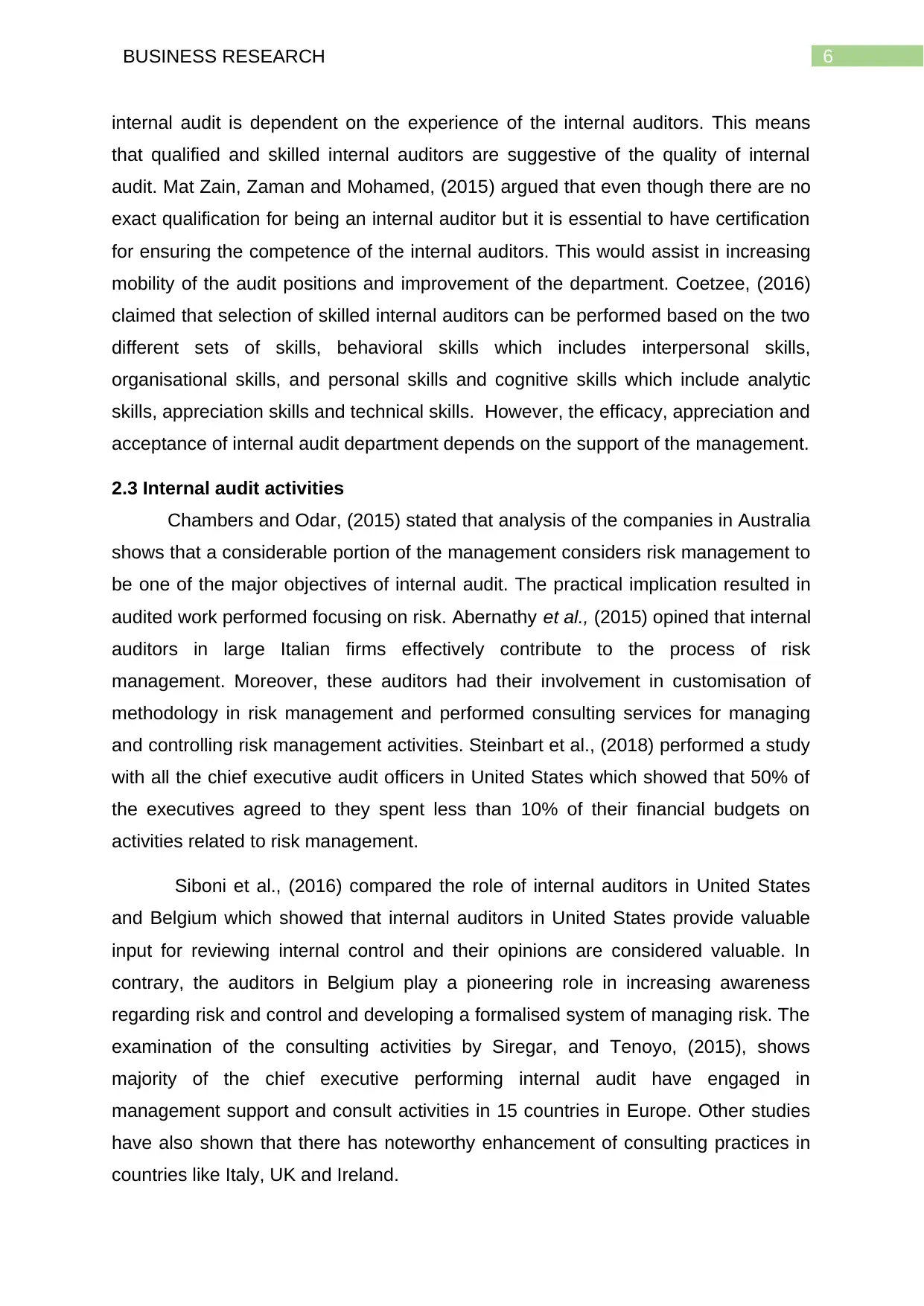
6BUSINESS RESEARCH
internal audit is dependent on the experience of the internal auditors. This means
that qualified and skilled internal auditors are suggestive of the quality of internal
audit. Mat Zain, Zaman and Mohamed, (2015) argued that even though there are no
exact qualification for being an internal auditor but it is essential to have certification
for ensuring the competence of the internal auditors. This would assist in increasing
mobility of the audit positions and improvement of the department. Coetzee, (2016)
claimed that selection of skilled internal auditors can be performed based on the two
different sets of skills, behavioral skills which includes interpersonal skills,
organisational skills, and personal skills and cognitive skills which include analytic
skills, appreciation skills and technical skills. However, the efficacy, appreciation and
acceptance of internal audit department depends on the support of the management.
2.3 Internal audit activities
Chambers and Odar, (2015) stated that analysis of the companies in Australia
shows that a considerable portion of the management considers risk management to
be one of the major objectives of internal audit. The practical implication resulted in
audited work performed focusing on risk. Abernathy et al., (2015) opined that internal
auditors in large Italian firms effectively contribute to the process of risk
management. Moreover, these auditors had their involvement in customisation of
methodology in risk management and performed consulting services for managing
and controlling risk management activities. Steinbart et al., (2018) performed a study
with all the chief executive audit officers in United States which showed that 50% of
the executives agreed to they spent less than 10% of their financial budgets on
activities related to risk management.
Siboni et al., (2016) compared the role of internal auditors in United States
and Belgium which showed that internal auditors in United States provide valuable
input for reviewing internal control and their opinions are considered valuable. In
contrary, the auditors in Belgium play a pioneering role in increasing awareness
regarding risk and control and developing a formalised system of managing risk. The
examination of the consulting activities by Siregar, and Tenoyo, (2015), shows
majority of the chief executive performing internal audit have engaged in
management support and consult activities in 15 countries in Europe. Other studies
have also shown that there has noteworthy enhancement of consulting practices in
countries like Italy, UK and Ireland.
internal audit is dependent on the experience of the internal auditors. This means
that qualified and skilled internal auditors are suggestive of the quality of internal
audit. Mat Zain, Zaman and Mohamed, (2015) argued that even though there are no
exact qualification for being an internal auditor but it is essential to have certification
for ensuring the competence of the internal auditors. This would assist in increasing
mobility of the audit positions and improvement of the department. Coetzee, (2016)
claimed that selection of skilled internal auditors can be performed based on the two
different sets of skills, behavioral skills which includes interpersonal skills,
organisational skills, and personal skills and cognitive skills which include analytic
skills, appreciation skills and technical skills. However, the efficacy, appreciation and
acceptance of internal audit department depends on the support of the management.
2.3 Internal audit activities
Chambers and Odar, (2015) stated that analysis of the companies in Australia
shows that a considerable portion of the management considers risk management to
be one of the major objectives of internal audit. The practical implication resulted in
audited work performed focusing on risk. Abernathy et al., (2015) opined that internal
auditors in large Italian firms effectively contribute to the process of risk
management. Moreover, these auditors had their involvement in customisation of
methodology in risk management and performed consulting services for managing
and controlling risk management activities. Steinbart et al., (2018) performed a study
with all the chief executive audit officers in United States which showed that 50% of
the executives agreed to they spent less than 10% of their financial budgets on
activities related to risk management.
Siboni et al., (2016) compared the role of internal auditors in United States
and Belgium which showed that internal auditors in United States provide valuable
input for reviewing internal control and their opinions are considered valuable. In
contrary, the auditors in Belgium play a pioneering role in increasing awareness
regarding risk and control and developing a formalised system of managing risk. The
examination of the consulting activities by Siregar, and Tenoyo, (2015), shows
majority of the chief executive performing internal audit have engaged in
management support and consult activities in 15 countries in Europe. Other studies
have also shown that there has noteworthy enhancement of consulting practices in
countries like Italy, UK and Ireland.
Paraphrase This Document
Need a fresh take? Get an instant paraphrase of this document with our AI Paraphraser
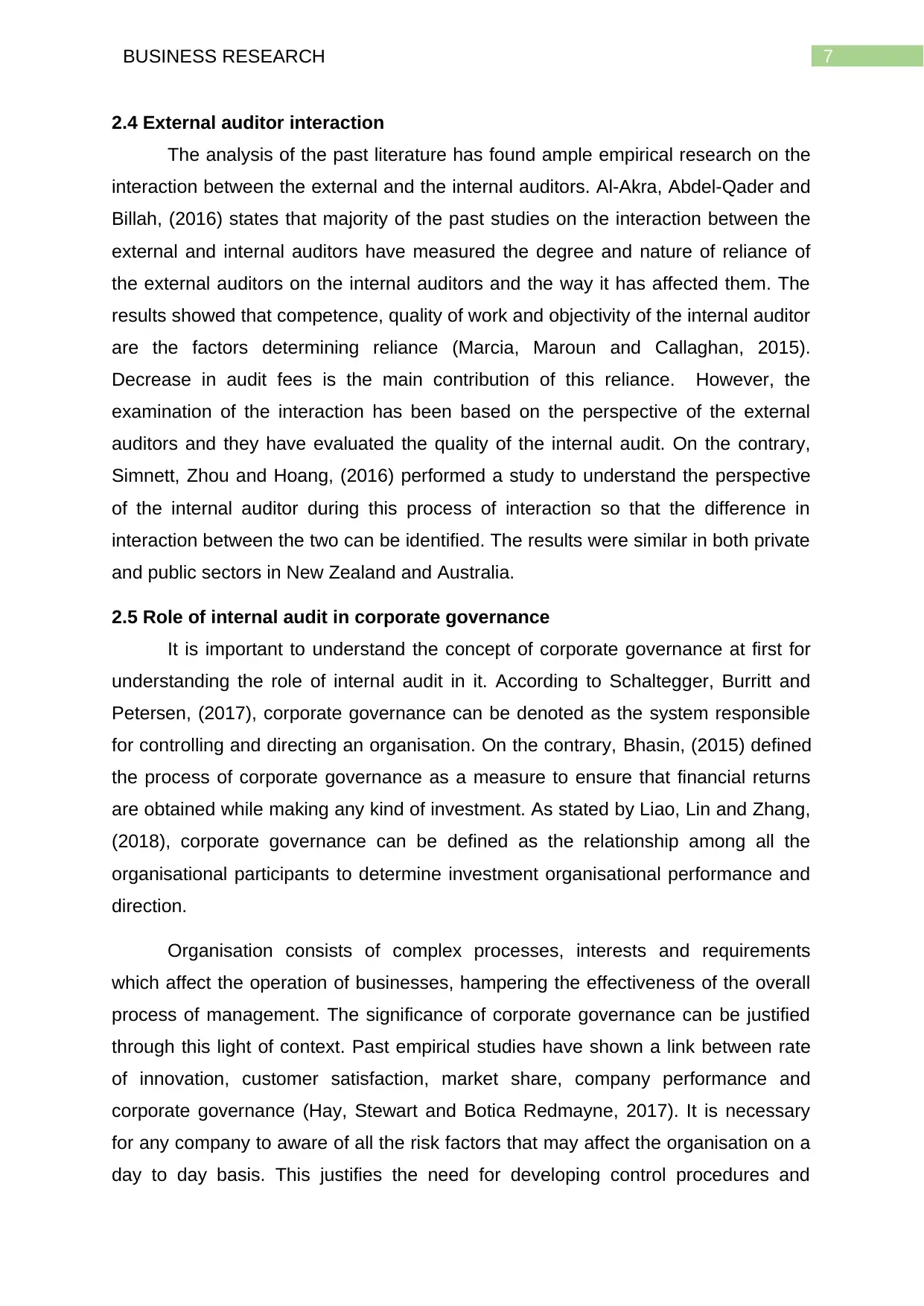
7BUSINESS RESEARCH
2.4 External auditor interaction
The analysis of the past literature has found ample empirical research on the
interaction between the external and the internal auditors. Al-Akra, Abdel-Qader and
Billah, (2016) states that majority of the past studies on the interaction between the
external and internal auditors have measured the degree and nature of reliance of
the external auditors on the internal auditors and the way it has affected them. The
results showed that competence, quality of work and objectivity of the internal auditor
are the factors determining reliance (Marcia, Maroun and Callaghan, 2015).
Decrease in audit fees is the main contribution of this reliance. However, the
examination of the interaction has been based on the perspective of the external
auditors and they have evaluated the quality of the internal audit. On the contrary,
Simnett, Zhou and Hoang, (2016) performed a study to understand the perspective
of the internal auditor during this process of interaction so that the difference in
interaction between the two can be identified. The results were similar in both private
and public sectors in New Zealand and Australia.
2.5 Role of internal audit in corporate governance
It is important to understand the concept of corporate governance at first for
understanding the role of internal audit in it. According to Schaltegger, Burritt and
Petersen, (2017), corporate governance can be denoted as the system responsible
for controlling and directing an organisation. On the contrary, Bhasin, (2015) defined
the process of corporate governance as a measure to ensure that financial returns
are obtained while making any kind of investment. As stated by Liao, Lin and Zhang,
(2018), corporate governance can be defined as the relationship among all the
organisational participants to determine investment organisational performance and
direction.
Organisation consists of complex processes, interests and requirements
which affect the operation of businesses, hampering the effectiveness of the overall
process of management. The significance of corporate governance can be justified
through this light of context. Past empirical studies have shown a link between rate
of innovation, customer satisfaction, market share, company performance and
corporate governance (Hay, Stewart and Botica Redmayne, 2017). It is necessary
for any company to aware of all the risk factors that may affect the organisation on a
day to day basis. This justifies the need for developing control procedures and
2.4 External auditor interaction
The analysis of the past literature has found ample empirical research on the
interaction between the external and the internal auditors. Al-Akra, Abdel-Qader and
Billah, (2016) states that majority of the past studies on the interaction between the
external and internal auditors have measured the degree and nature of reliance of
the external auditors on the internal auditors and the way it has affected them. The
results showed that competence, quality of work and objectivity of the internal auditor
are the factors determining reliance (Marcia, Maroun and Callaghan, 2015).
Decrease in audit fees is the main contribution of this reliance. However, the
examination of the interaction has been based on the perspective of the external
auditors and they have evaluated the quality of the internal audit. On the contrary,
Simnett, Zhou and Hoang, (2016) performed a study to understand the perspective
of the internal auditor during this process of interaction so that the difference in
interaction between the two can be identified. The results were similar in both private
and public sectors in New Zealand and Australia.
2.5 Role of internal audit in corporate governance
It is important to understand the concept of corporate governance at first for
understanding the role of internal audit in it. According to Schaltegger, Burritt and
Petersen, (2017), corporate governance can be denoted as the system responsible
for controlling and directing an organisation. On the contrary, Bhasin, (2015) defined
the process of corporate governance as a measure to ensure that financial returns
are obtained while making any kind of investment. As stated by Liao, Lin and Zhang,
(2018), corporate governance can be defined as the relationship among all the
organisational participants to determine investment organisational performance and
direction.
Organisation consists of complex processes, interests and requirements
which affect the operation of businesses, hampering the effectiveness of the overall
process of management. The significance of corporate governance can be justified
through this light of context. Past empirical studies have shown a link between rate
of innovation, customer satisfaction, market share, company performance and
corporate governance (Hay, Stewart and Botica Redmayne, 2017). It is necessary
for any company to aware of all the risk factors that may affect the organisation on a
day to day basis. This justifies the need for developing control procedures and
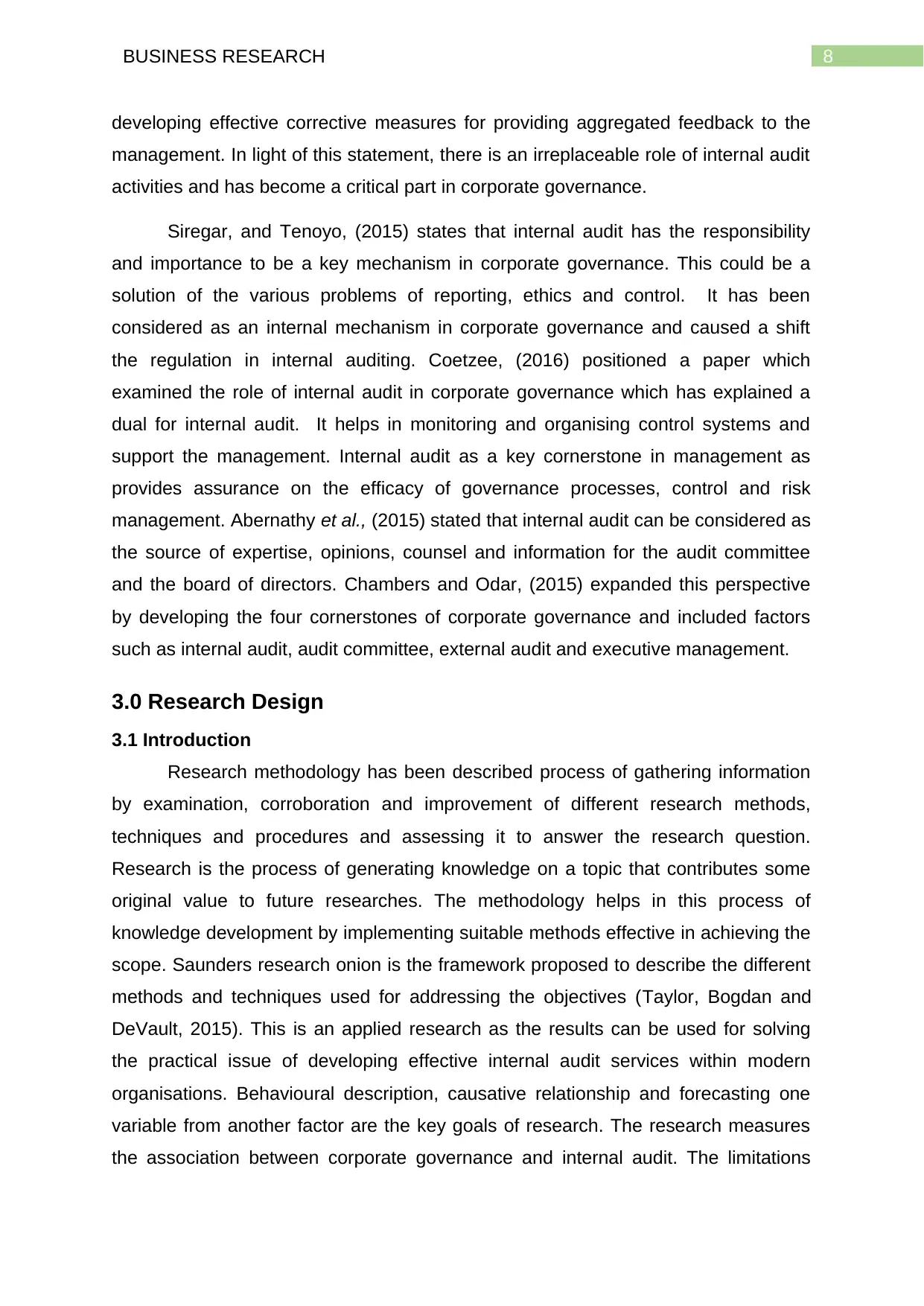
8BUSINESS RESEARCH
developing effective corrective measures for providing aggregated feedback to the
management. In light of this statement, there is an irreplaceable role of internal audit
activities and has become a critical part in corporate governance.
Siregar, and Tenoyo, (2015) states that internal audit has the responsibility
and importance to be a key mechanism in corporate governance. This could be a
solution of the various problems of reporting, ethics and control. It has been
considered as an internal mechanism in corporate governance and caused a shift
the regulation in internal auditing. Coetzee, (2016) positioned a paper which
examined the role of internal audit in corporate governance which has explained a
dual for internal audit. It helps in monitoring and organising control systems and
support the management. Internal audit as a key cornerstone in management as
provides assurance on the efficacy of governance processes, control and risk
management. Abernathy et al., (2015) stated that internal audit can be considered as
the source of expertise, opinions, counsel and information for the audit committee
and the board of directors. Chambers and Odar, (2015) expanded this perspective
by developing the four cornerstones of corporate governance and included factors
such as internal audit, audit committee, external audit and executive management.
3.0 Research Design
3.1 Introduction
Research methodology has been described process of gathering information
by examination, corroboration and improvement of different research methods,
techniques and procedures and assessing it to answer the research question.
Research is the process of generating knowledge on a topic that contributes some
original value to future researches. The methodology helps in this process of
knowledge development by implementing suitable methods effective in achieving the
scope. Saunders research onion is the framework proposed to describe the different
methods and techniques used for addressing the objectives (Taylor, Bogdan and
DeVault, 2015). This is an applied research as the results can be used for solving
the practical issue of developing effective internal audit services within modern
organisations. Behavioural description, causative relationship and forecasting one
variable from another factor are the key goals of research. The research measures
the association between corporate governance and internal audit. The limitations
developing effective corrective measures for providing aggregated feedback to the
management. In light of this statement, there is an irreplaceable role of internal audit
activities and has become a critical part in corporate governance.
Siregar, and Tenoyo, (2015) states that internal audit has the responsibility
and importance to be a key mechanism in corporate governance. This could be a
solution of the various problems of reporting, ethics and control. It has been
considered as an internal mechanism in corporate governance and caused a shift
the regulation in internal auditing. Coetzee, (2016) positioned a paper which
examined the role of internal audit in corporate governance which has explained a
dual for internal audit. It helps in monitoring and organising control systems and
support the management. Internal audit as a key cornerstone in management as
provides assurance on the efficacy of governance processes, control and risk
management. Abernathy et al., (2015) stated that internal audit can be considered as
the source of expertise, opinions, counsel and information for the audit committee
and the board of directors. Chambers and Odar, (2015) expanded this perspective
by developing the four cornerstones of corporate governance and included factors
such as internal audit, audit committee, external audit and executive management.
3.0 Research Design
3.1 Introduction
Research methodology has been described process of gathering information
by examination, corroboration and improvement of different research methods,
techniques and procedures and assessing it to answer the research question.
Research is the process of generating knowledge on a topic that contributes some
original value to future researches. The methodology helps in this process of
knowledge development by implementing suitable methods effective in achieving the
scope. Saunders research onion is the framework proposed to describe the different
methods and techniques used for addressing the objectives (Taylor, Bogdan and
DeVault, 2015). This is an applied research as the results can be used for solving
the practical issue of developing effective internal audit services within modern
organisations. Behavioural description, causative relationship and forecasting one
variable from another factor are the key goals of research. The research measures
the association between corporate governance and internal audit. The limitations
⊘ This is a preview!⊘
Do you want full access?
Subscribe today to unlock all pages.

Trusted by 1+ million students worldwide
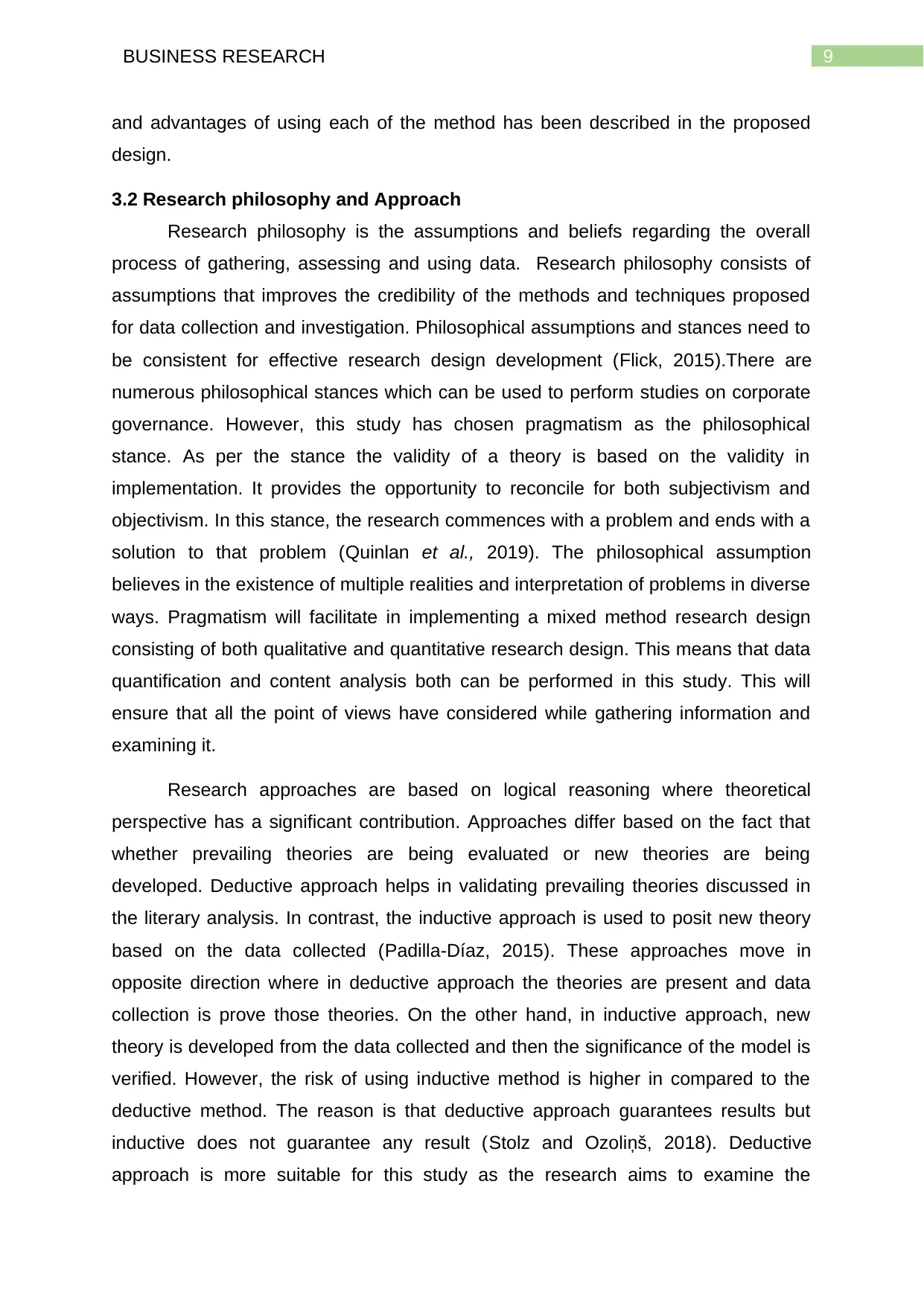
9BUSINESS RESEARCH
and advantages of using each of the method has been described in the proposed
design.
3.2 Research philosophy and Approach
Research philosophy is the assumptions and beliefs regarding the overall
process of gathering, assessing and using data. Research philosophy consists of
assumptions that improves the credibility of the methods and techniques proposed
for data collection and investigation. Philosophical assumptions and stances need to
be consistent for effective research design development (Flick, 2015).There are
numerous philosophical stances which can be used to perform studies on corporate
governance. However, this study has chosen pragmatism as the philosophical
stance. As per the stance the validity of a theory is based on the validity in
implementation. It provides the opportunity to reconcile for both subjectivism and
objectivism. In this stance, the research commences with a problem and ends with a
solution to that problem (Quinlan et al., 2019). The philosophical assumption
believes in the existence of multiple realities and interpretation of problems in diverse
ways. Pragmatism will facilitate in implementing a mixed method research design
consisting of both qualitative and quantitative research design. This means that data
quantification and content analysis both can be performed in this study. This will
ensure that all the point of views have considered while gathering information and
examining it.
Research approaches are based on logical reasoning where theoretical
perspective has a significant contribution. Approaches differ based on the fact that
whether prevailing theories are being evaluated or new theories are being
developed. Deductive approach helps in validating prevailing theories discussed in
the literary analysis. In contrast, the inductive approach is used to posit new theory
based on the data collected (Padilla-Díaz, 2015). These approaches move in
opposite direction where in deductive approach the theories are present and data
collection is prove those theories. On the other hand, in inductive approach, new
theory is developed from the data collected and then the significance of the model is
verified. However, the risk of using inductive method is higher in compared to the
deductive method. The reason is that deductive approach guarantees results but
inductive does not guarantee any result (Stolz and Ozoliņš, 2018). Deductive
approach is more suitable for this study as the research aims to examine the
and advantages of using each of the method has been described in the proposed
design.
3.2 Research philosophy and Approach
Research philosophy is the assumptions and beliefs regarding the overall
process of gathering, assessing and using data. Research philosophy consists of
assumptions that improves the credibility of the methods and techniques proposed
for data collection and investigation. Philosophical assumptions and stances need to
be consistent for effective research design development (Flick, 2015).There are
numerous philosophical stances which can be used to perform studies on corporate
governance. However, this study has chosen pragmatism as the philosophical
stance. As per the stance the validity of a theory is based on the validity in
implementation. It provides the opportunity to reconcile for both subjectivism and
objectivism. In this stance, the research commences with a problem and ends with a
solution to that problem (Quinlan et al., 2019). The philosophical assumption
believes in the existence of multiple realities and interpretation of problems in diverse
ways. Pragmatism will facilitate in implementing a mixed method research design
consisting of both qualitative and quantitative research design. This means that data
quantification and content analysis both can be performed in this study. This will
ensure that all the point of views have considered while gathering information and
examining it.
Research approaches are based on logical reasoning where theoretical
perspective has a significant contribution. Approaches differ based on the fact that
whether prevailing theories are being evaluated or new theories are being
developed. Deductive approach helps in validating prevailing theories discussed in
the literary analysis. In contrast, the inductive approach is used to posit new theory
based on the data collected (Padilla-Díaz, 2015). These approaches move in
opposite direction where in deductive approach the theories are present and data
collection is prove those theories. On the other hand, in inductive approach, new
theory is developed from the data collected and then the significance of the model is
verified. However, the risk of using inductive method is higher in compared to the
deductive method. The reason is that deductive approach guarantees results but
inductive does not guarantee any result (Stolz and Ozoliņš, 2018). Deductive
approach is more suitable for this study as the research aims to examine the
Paraphrase This Document
Need a fresh take? Get an instant paraphrase of this document with our AI Paraphraser
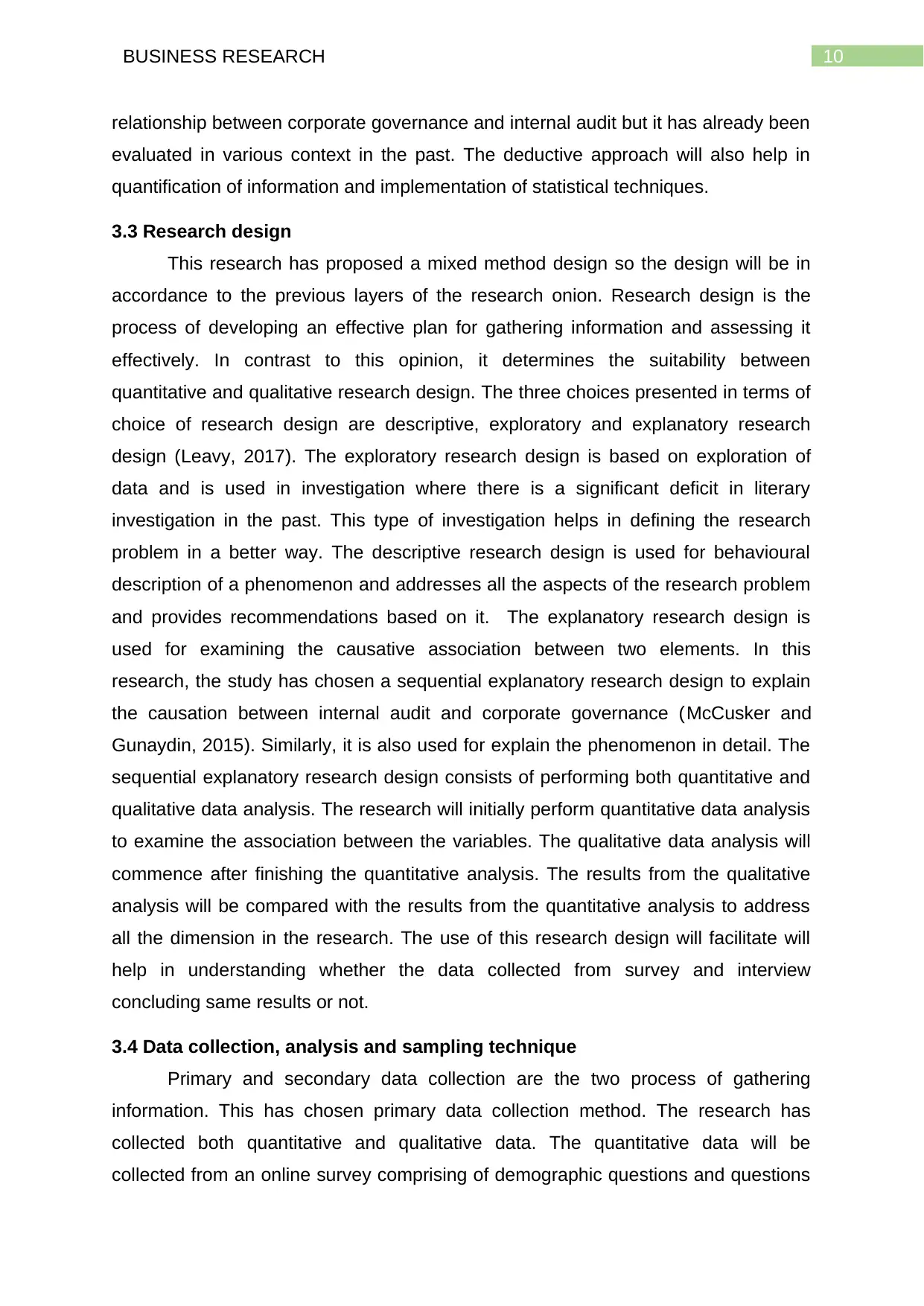
10BUSINESS RESEARCH
relationship between corporate governance and internal audit but it has already been
evaluated in various context in the past. The deductive approach will also help in
quantification of information and implementation of statistical techniques.
3.3 Research design
This research has proposed a mixed method design so the design will be in
accordance to the previous layers of the research onion. Research design is the
process of developing an effective plan for gathering information and assessing it
effectively. In contrast to this opinion, it determines the suitability between
quantitative and qualitative research design. The three choices presented in terms of
choice of research design are descriptive, exploratory and explanatory research
design (Leavy, 2017). The exploratory research design is based on exploration of
data and is used in investigation where there is a significant deficit in literary
investigation in the past. This type of investigation helps in defining the research
problem in a better way. The descriptive research design is used for behavioural
description of a phenomenon and addresses all the aspects of the research problem
and provides recommendations based on it. The explanatory research design is
used for examining the causative association between two elements. In this
research, the study has chosen a sequential explanatory research design to explain
the causation between internal audit and corporate governance (McCusker and
Gunaydin, 2015). Similarly, it is also used for explain the phenomenon in detail. The
sequential explanatory research design consists of performing both quantitative and
qualitative data analysis. The research will initially perform quantitative data analysis
to examine the association between the variables. The qualitative data analysis will
commence after finishing the quantitative analysis. The results from the qualitative
analysis will be compared with the results from the quantitative analysis to address
all the dimension in the research. The use of this research design will facilitate will
help in understanding whether the data collected from survey and interview
concluding same results or not.
3.4 Data collection, analysis and sampling technique
Primary and secondary data collection are the two process of gathering
information. This has chosen primary data collection method. The research has
collected both quantitative and qualitative data. The quantitative data will be
collected from an online survey comprising of demographic questions and questions
relationship between corporate governance and internal audit but it has already been
evaluated in various context in the past. The deductive approach will also help in
quantification of information and implementation of statistical techniques.
3.3 Research design
This research has proposed a mixed method design so the design will be in
accordance to the previous layers of the research onion. Research design is the
process of developing an effective plan for gathering information and assessing it
effectively. In contrast to this opinion, it determines the suitability between
quantitative and qualitative research design. The three choices presented in terms of
choice of research design are descriptive, exploratory and explanatory research
design (Leavy, 2017). The exploratory research design is based on exploration of
data and is used in investigation where there is a significant deficit in literary
investigation in the past. This type of investigation helps in defining the research
problem in a better way. The descriptive research design is used for behavioural
description of a phenomenon and addresses all the aspects of the research problem
and provides recommendations based on it. The explanatory research design is
used for examining the causative association between two elements. In this
research, the study has chosen a sequential explanatory research design to explain
the causation between internal audit and corporate governance (McCusker and
Gunaydin, 2015). Similarly, it is also used for explain the phenomenon in detail. The
sequential explanatory research design consists of performing both quantitative and
qualitative data analysis. The research will initially perform quantitative data analysis
to examine the association between the variables. The qualitative data analysis will
commence after finishing the quantitative analysis. The results from the qualitative
analysis will be compared with the results from the quantitative analysis to address
all the dimension in the research. The use of this research design will facilitate will
help in understanding whether the data collected from survey and interview
concluding same results or not.
3.4 Data collection, analysis and sampling technique
Primary and secondary data collection are the two process of gathering
information. This has chosen primary data collection method. The research has
collected both quantitative and qualitative data. The quantitative data will be
collected from an online survey comprising of demographic questions and questions
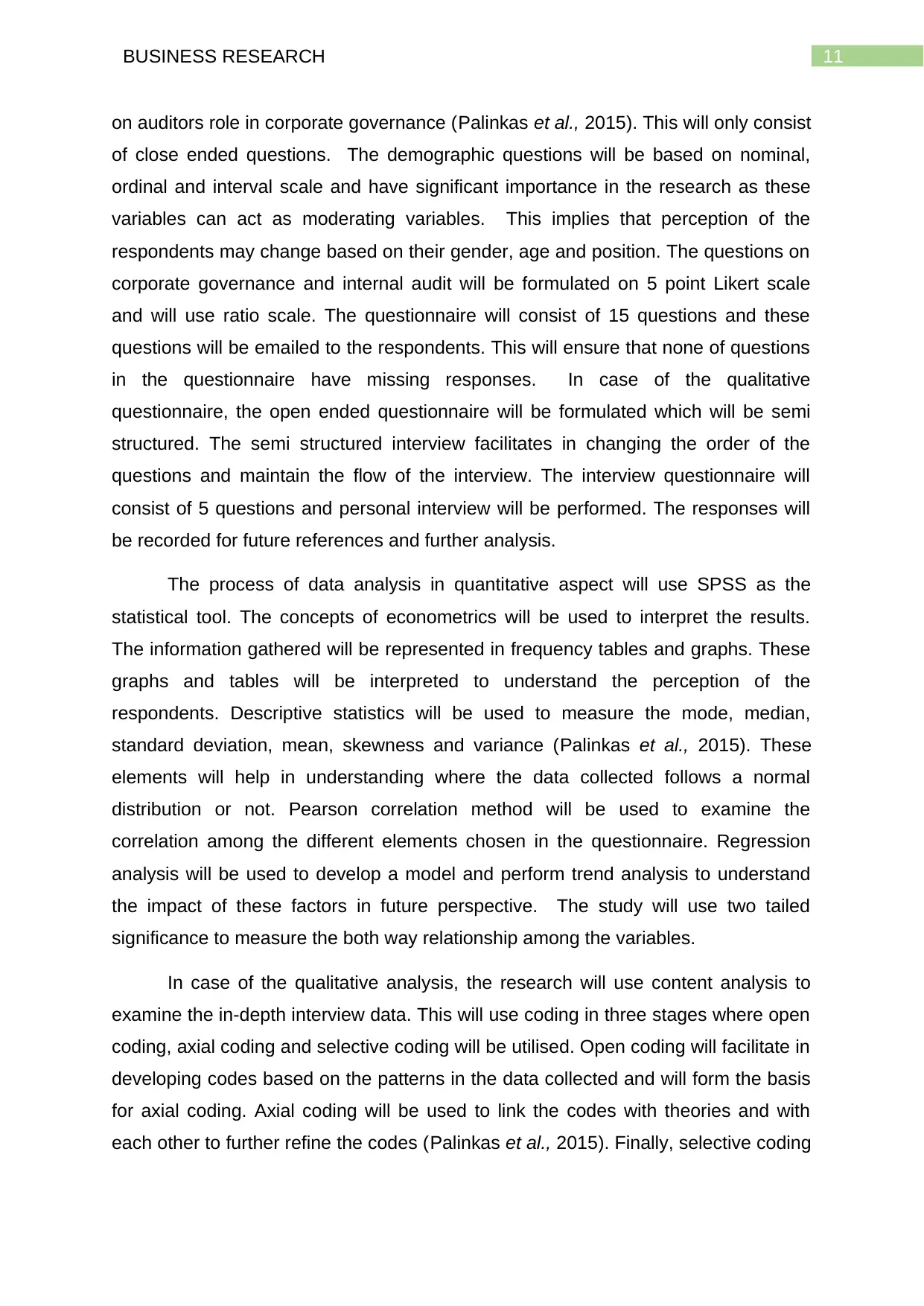
11BUSINESS RESEARCH
on auditors role in corporate governance (Palinkas et al., 2015). This will only consist
of close ended questions. The demographic questions will be based on nominal,
ordinal and interval scale and have significant importance in the research as these
variables can act as moderating variables. This implies that perception of the
respondents may change based on their gender, age and position. The questions on
corporate governance and internal audit will be formulated on 5 point Likert scale
and will use ratio scale. The questionnaire will consist of 15 questions and these
questions will be emailed to the respondents. This will ensure that none of questions
in the questionnaire have missing responses. In case of the qualitative
questionnaire, the open ended questionnaire will be formulated which will be semi
structured. The semi structured interview facilitates in changing the order of the
questions and maintain the flow of the interview. The interview questionnaire will
consist of 5 questions and personal interview will be performed. The responses will
be recorded for future references and further analysis.
The process of data analysis in quantitative aspect will use SPSS as the
statistical tool. The concepts of econometrics will be used to interpret the results.
The information gathered will be represented in frequency tables and graphs. These
graphs and tables will be interpreted to understand the perception of the
respondents. Descriptive statistics will be used to measure the mode, median,
standard deviation, mean, skewness and variance (Palinkas et al., 2015). These
elements will help in understanding where the data collected follows a normal
distribution or not. Pearson correlation method will be used to examine the
correlation among the different elements chosen in the questionnaire. Regression
analysis will be used to develop a model and perform trend analysis to understand
the impact of these factors in future perspective. The study will use two tailed
significance to measure the both way relationship among the variables.
In case of the qualitative analysis, the research will use content analysis to
examine the in-depth interview data. This will use coding in three stages where open
coding, axial coding and selective coding will be utilised. Open coding will facilitate in
developing codes based on the patterns in the data collected and will form the basis
for axial coding. Axial coding will be used to link the codes with theories and with
each other to further refine the codes (Palinkas et al., 2015). Finally, selective coding
on auditors role in corporate governance (Palinkas et al., 2015). This will only consist
of close ended questions. The demographic questions will be based on nominal,
ordinal and interval scale and have significant importance in the research as these
variables can act as moderating variables. This implies that perception of the
respondents may change based on their gender, age and position. The questions on
corporate governance and internal audit will be formulated on 5 point Likert scale
and will use ratio scale. The questionnaire will consist of 15 questions and these
questions will be emailed to the respondents. This will ensure that none of questions
in the questionnaire have missing responses. In case of the qualitative
questionnaire, the open ended questionnaire will be formulated which will be semi
structured. The semi structured interview facilitates in changing the order of the
questions and maintain the flow of the interview. The interview questionnaire will
consist of 5 questions and personal interview will be performed. The responses will
be recorded for future references and further analysis.
The process of data analysis in quantitative aspect will use SPSS as the
statistical tool. The concepts of econometrics will be used to interpret the results.
The information gathered will be represented in frequency tables and graphs. These
graphs and tables will be interpreted to understand the perception of the
respondents. Descriptive statistics will be used to measure the mode, median,
standard deviation, mean, skewness and variance (Palinkas et al., 2015). These
elements will help in understanding where the data collected follows a normal
distribution or not. Pearson correlation method will be used to examine the
correlation among the different elements chosen in the questionnaire. Regression
analysis will be used to develop a model and perform trend analysis to understand
the impact of these factors in future perspective. The study will use two tailed
significance to measure the both way relationship among the variables.
In case of the qualitative analysis, the research will use content analysis to
examine the in-depth interview data. This will use coding in three stages where open
coding, axial coding and selective coding will be utilised. Open coding will facilitate in
developing codes based on the patterns in the data collected and will form the basis
for axial coding. Axial coding will be used to link the codes with theories and with
each other to further refine the codes (Palinkas et al., 2015). Finally, selective coding
⊘ This is a preview!⊘
Do you want full access?
Subscribe today to unlock all pages.

Trusted by 1+ million students worldwide
1 out of 17
Related Documents
Your All-in-One AI-Powered Toolkit for Academic Success.
+13062052269
info@desklib.com
Available 24*7 on WhatsApp / Email
![[object Object]](/_next/static/media/star-bottom.7253800d.svg)
Unlock your academic potential
Copyright © 2020–2025 A2Z Services. All Rights Reserved. Developed and managed by ZUCOL.




